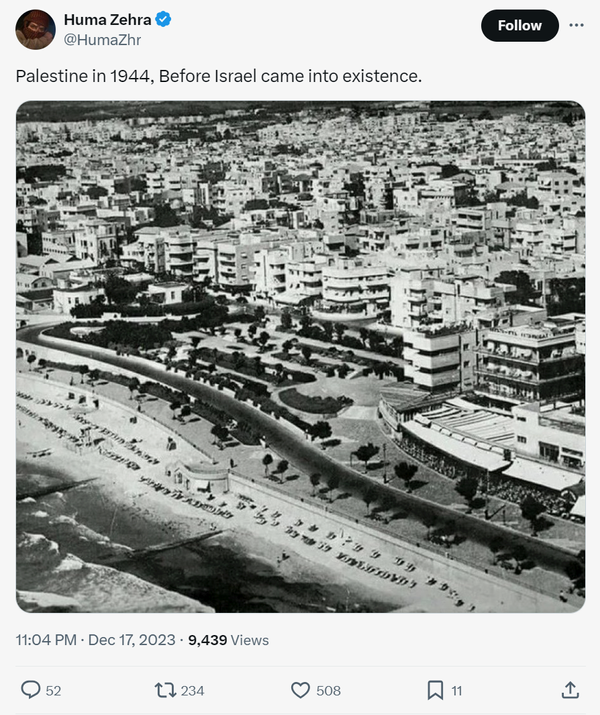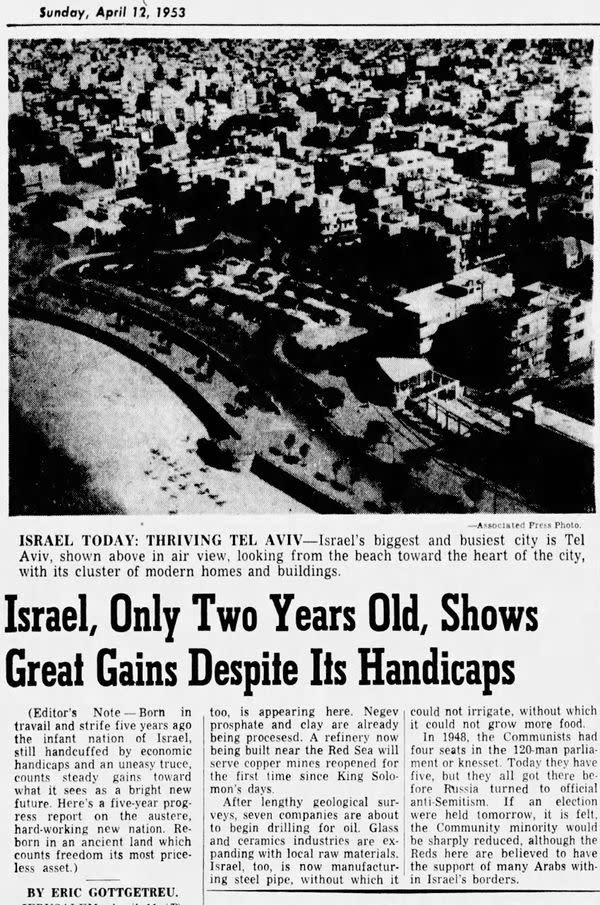In late 2023 and early 2024, as the war between Israel and Hamas raged, a photo circulated on social media with several versions of a similar claim (archived). The contributions assumed that the photo was taken in Palestine, before Zionism and before the founding of Israel:


(X-User @HumaZhr)
A post on X had received 5.7 million views, 17,600 likes and more than 6,000 shares. The photo also appeared on Reddit with the tag “imperialism,” where it was upvoted 5,100 times.
What year was the photo taken?
The photo is difficult to date. A reverse image search using TinEye and Google revealed several references for this image, all of which confirm that it is an aerial photograph of part of the Tel Aviv promenade. Tel Aviv is Israel’s second largest city.
One of the references is the catalogue of the 2013 exhibition “White City: Bauhaus Architecture in Tel Aviv” at the Hermitage Museum in St. Petersburg, Russia.
Another blog post from 2013 includes a photo of a 2002 book by Nahoum Cohen called “Bauhaus Tel Aviv.” The blog post dates the photo to 1940, presumably referring to the book.
We found a very similar image – although not the same – on the eBay page of an antique and vintage photography dealer. The product detail page is titled “Epic Aerial View of Historic City of TEL AVIV, Israel, Vintage Press Photo 1953.” It includes a photo of the back of the photo, which has the following text on it:
B16324
WIDE WORLD
PLEASE CREDIT
(For use Sunday, April 12, with Eric Gottgetreu’s Jerusalem AP-N story on Israel’s 5th anniversary.)ISRAEL TODAY: THE FLOWERING TEL AVIV
Israel’s largest and busiest city is Tel Aviv, seen in the aerial photo above, looking from the beach towards the city center with its many modern houses and buildings. Together with neighboring Jaffa, the city has a population of 400,000. Close to Tel Aviv is the large international airport LOD (Lydda), home of the Israeli national airline “El Al.”5392 1135A- 4/3/53 AJE F WAB165
On this text is a stamp in purple ink with the inscription “RECEIVED FROM EXAMINER REFERENCE LIBRARY, APRIL 12, 1953.”
This photo shows a less built-up landscape, smaller trees, and few people on the beach, suggesting it may have been taken earlier than the photo in the viral posts.
Nevertheless, we used this information in a search on newspapers.com, a website that compiles newspaper archives, and found several references to articles that published this photo on April 12, 1953, and days later – using Gottgetreu’s article and part or all of the caption quoted above. This one is from the Fort Worth Star-Telegram (note that the headline is incorrect: in 1953, Israel had existed for five years, not two):


(newspaper.com)
Unfortunately, even this date and stamp cannot guarantee that the photo was taken in 1953, as press practices regarding the use of images were not as strict back then as they are in the 21st century. Not to mention, a deep dive into Tel Aviv’s history confirms that this beach was most likely built in the 1930s.
Bauhaus and Tel Aviv
As soon as Adolf Hitler was elected Chancellor in 1933, thousands of Jews left Germany for Mandatory Palestine. The wave of emigration intensified in 1935, when the Nuremberg Laws came into force, depriving German Jews of their rights. It continued until 1939, when Hitler invaded Poland and France and Britain declared war. In 1941, Hitler decided that instead of encouraging Jewish emigration from Europe, he would focus on exterminating the Jews.
Hitler’s rise to power also led to the closure of the Bauhaus art school in 1933. According to journalist and Pulitzer Center Fellow Verónica Zaragovia, the Nazis were hostile to the Bauhaus “because it was avant-garde and utopian. Because some of its members had ties to the Soviet Union or communists, others were Jewish.” This led to at least half of the students and professors leaving Germany. But rather than marking the end of the Bauhaus movement, it led to its revival elsewhere in the world – most notably in Tel Aviv.
In the 1930s, Tel Aviv experienced a construction boom. The city was founded by Jews in 1906 under Ottoman rule and was initially called Ahuzat Bayit (“homeland” in Hebrew). To circumvent laws prohibiting the sale of land to Jewish subjects of the Ottoman Empire, a Jewish banker named Jacobus Kann used his Dutch citizenship to buy the first 60 plots in his name.
Construction of Tel Aviv began in earnest in the 1920s and accelerated in the 1930s with the arrival of Jewish-German émigrés. The timing helped make Tel Aviv a jewel of Bauhaus architecture. Zaragovia wrote:
The students and teachers who left the city spread Bauhaus designs and helped them flourish around the world, including in the United States and Israel. This was the case in Tel Aviv, a city where I lived for about a year after college. There are about 4,000 Bauhaus-influenced buildings scattered throughout the city, designed by Jewish architects, some of whom had studied at the Bauhaus. They have flat roofs, balconies, and simple straight or curved lines.
The over 4,000 buildings constructed in the 1930s became collectively known as the White City. The White City was added to the UNESCO World Heritage Center as a protected site in 2003 (see map of protected areas). Architecture Digest published an article in 2019 about some of the best examples of this architecture in Tel Aviv.
In summary, the photo is a snapshot of Tel Aviv’s early days. Although it was founded under Ottoman rule, it was expanded by a growing Jewish community during the British Mandate in Palestine. In other words, this was a city created by the Zionist movement before the creation of Israel.
In 2023, Snopes investigated whether another photo shows a street in Jerusalem before the founding of the State of Israel.
Sources:
“10 of the best examples of Bauhaus architecture in Tel Aviv”. DezeenAugust 24, 2016, https://www.dezeen.com/2016/08/24/10-tel-aviv-best-examples-bauhaus-residential-architecture/.
“April 12, 1953, Page 19 – Fort Worth Star-Telegram at Newspapers.Com.” Newspapers.Comhttps://www.newspapers.com/image/636730570/. Retrieved April 17, 2024.
“100 Years of Bauhaus”. @GI_worldwidehttps://www.goethe.de/prj/tbp/en/bpa/yea.html. Retrieved April 17, 2024.
Azoulay, Yuval. “Jacobus Street, corner of Oblivion.” HaaretzApril 1, 2009, https://web.archive.org/web/20120404193456/http://www.haaretz.com/print-edition/features/jacobus-street-corner-of-oblivion-1.273311.
Center, UNESCO World Heritage Site. “White City Tel-Aviv – the modern movement”. UNESCO World Heritage Centrehttps://whc.unesco.org/en/list/1096/. Retrieved 17 April 2024.
Cohen, Alina. “Emerging painter Kira Maria Shewfelt transforms moments of passion into surreal canvases.” ArtisticApril 16, 2024, https://www.artsy.net/article/artsy-editorial-emerging-painter-kira-maria-shewfelt-transforms-moments-passion-surreal-canvases.
Emigration 1933-1941 – The Holocaust explained: Designed for schools. January 4, 1933, https://www.theholocaustexplained.org/resistance-responses-collaboration/responses/emigration/.
Warkentin, Elizabeth. “How did Tel Aviv become a beacon of breathtaking Bauhaus architecture?” Architecture DigestSeptember 25, 2019, https://www.architecturaldigest.com/story/how-did-tel-aviv-become-beacon-stunning-bauhaus-architecture.
Update:
April 24, 2024: This report has been updated to include additional information about when the photo was taken.




